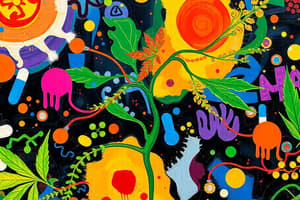Podcast
Questions and Answers
Which endocannabinoid is primarily broken down by fatty acid amide hydrolase (FAAH)?
Which endocannabinoid is primarily broken down by fatty acid amide hydrolase (FAAH)?
- CB2
- 2-AG
- Anandamide (correct)
- CB1
What is the primary function of the CB2 receptor?
What is the primary function of the CB2 receptor?
- Regulating appetite
- Modulating sensory processing
- Coordinating motor functions
- Influencing immune response (correct)
Which of the following compounds is non-psychoactive?
Which of the following compounds is non-psychoactive?
- Both B and C (correct)
- Cannabinol (CBN)
- Cannabidiol (CBD)
- Delta-9-tetrahydrocannabinol (THC)
What is the primary role of endocannabinoids in synaptic transmission?
What is the primary role of endocannabinoids in synaptic transmission?
Where are very few receptors for the cannabinoid system located?
Where are very few receptors for the cannabinoid system located?
Which of the following compounds is considered an active metabolite of THC?
Which of the following compounds is considered an active metabolite of THC?
Which bodily function is NOT influenced by the endocannabinoid system?
Which bodily function is NOT influenced by the endocannabinoid system?
What is the main precursor for the synthesis of endocannabinoids?
What is the main precursor for the synthesis of endocannabinoids?
What is one medical use of THC?
What is one medical use of THC?
Which timeline event signifies the identification of the first cannabinoid receptor?
Which timeline event signifies the identification of the first cannabinoid receptor?
Flashcards
Endocannabinoids
Endocannabinoids
Lipid-based signaling molecules produced by the body that interact with cannabinoid receptors.
CB1 Receptor
CB1 Receptor
A cannabinoid receptor primarily located in the central nervous system, affecting functions like motor coordination and memory.
CB2 Receptor
CB2 Receptor
A cannabinoid receptor primarily located in the periphery, particularly the immune system.
Anandamide
Anandamide
Signup and view all the flashcards
2-AG
2-AG
Signup and view all the flashcards
Retrograde signaling
Retrograde signaling
Signup and view all the flashcards
THC
THC
Signup and view all the flashcards
Cannabis Sativa
Cannabis Sativa
Signup and view all the flashcards
Medical Use (THC) - Analgesia
Medical Use (THC) - Analgesia
Signup and view all the flashcards
Pharmacokinetics (THC)
Pharmacokinetics (THC)
Signup and view all the flashcards
Study Notes
Endocannabinoid System
- Endocannabinoids: Lipid-soluble molecules synthesized on demand, not stored in vesicles
- Functions: Analgesia, sensory processing, motor coordination, memory, cognition, appetite, immune system regulation
- Synthesis: Derived from arachidonic acid
- Receptors: CB1 (CNS), CB2 (peripheral, immune system); few receptors in brainstem
- Location of CB1 Receptors: Basal ganglia, cerebellum, hippocampus, cortex, spinal cord, hypothalamus
- Inactivation: Uptake by endocannabinoid membrane transporter; breakdown by FAAH (for anandamide) and MGL (for 2-AG)
- Synaptic Transmission: Diffuse across synapse, bind to presynaptic receptors, inhibit neurotransmitter release (retrograde signaling)
- Depolarization of Postsynaptic Neuron: Triggers endocannabinoid synthesis
- Role in Presynaptic Inhibition: Reduces neurotransmitter release
Cannabis
- Plants: Cannabis sativa and Cannabis indica (hemp)
- Origin: Native to Asia, cultivated globally for ~6000 years
- Historical Significance: American colonies used hemp for ropes
- Propaganda: Anti-cannabis campaigns emerged in the 1930s
- Compounds: ~400 active compounds
- Psychoactive: Delta-9-tetrahydrocannabinol (THC) – identified in 1964
- Non-psychoactive: Cannabidiol (CBD), Cannabinol (CBN)
- Timeline of Discoveries:
- 1964: THC identified
- 1988: CB1 receptor identified
- 1991: CB2 receptor identified
- 1992: Endogenous endocannabinoids (anandamide and 2-AG) identified
- Pharmacokinetics of THC:
- Half-life ~30 hours
- Depot binding (reverse tolerance)
- Metabolized to 11-hydroxy-delta-9-THC; inactive metabolite: carboxy-THC (urine test)
- Medical Uses: Analgesia (Sativex), Appetite Stimulation (Marinol), Pain (inflammatory conditions), Treatment for conditions like cancer or AIDS
- Cannabinoid Antagonists: Rimonabant (2006) now rarely used for appetite suppression due to side effects
Studying That Suits You
Use AI to generate personalized quizzes and flashcards to suit your learning preferences.



